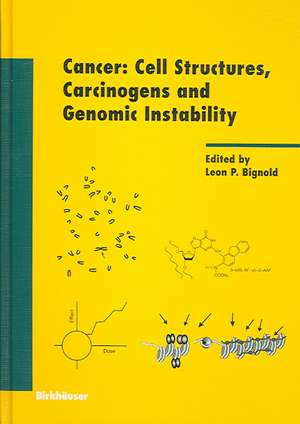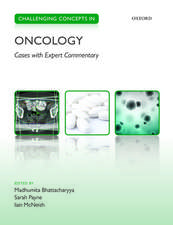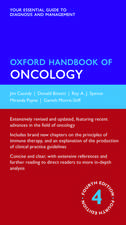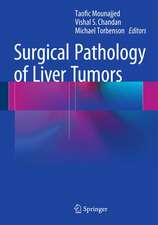Cancer: Cell Structures, Carcinogens and Genomic Instability: Experientia Supplementum, cartea 96
Editat de Leon P. Bignolden Limba Engleză Hardback – 18 noi 2005
Din seria Experientia Supplementum
- 5%
 Preț: 1343.50 lei
Preț: 1343.50 lei - 5%
 Preț: 984.91 lei
Preț: 984.91 lei -
 Preț: 330.76 lei
Preț: 330.76 lei -
 Preț: 282.83 lei
Preț: 282.83 lei -
 Preț: 302.84 lei
Preț: 302.84 lei -
 Preț: 192.21 lei
Preț: 192.21 lei - 5%
 Preț: 369.45 lei
Preț: 369.45 lei - 5%
 Preț: 382.62 lei
Preț: 382.62 lei - 15%
 Preț: 644.18 lei
Preț: 644.18 lei - 18%
 Preț: 944.51 lei
Preț: 944.51 lei - 18%
 Preț: 944.51 lei
Preț: 944.51 lei - 5%
 Preț: 715.55 lei
Preț: 715.55 lei - 15%
 Preț: 647.40 lei
Preț: 647.40 lei - 15%
 Preț: 646.94 lei
Preț: 646.94 lei - 5%
 Preț: 1430.00 lei
Preț: 1430.00 lei - 5%
 Preț: 1107.58 lei
Preț: 1107.58 lei - 5%
 Preț: 1048.73 lei
Preț: 1048.73 lei - 5%
 Preț: 902.80 lei
Preț: 902.80 lei - 5%
 Preț: 1294.47 lei
Preț: 1294.47 lei - 5%
 Preț: 1287.38 lei
Preț: 1287.38 lei - 18%
 Preț: 950.66 lei
Preț: 950.66 lei -
 Preț: 343.59 lei
Preț: 343.59 lei -
 Preț: 401.24 lei
Preț: 401.24 lei - 15%
 Preț: 666.24 lei
Preț: 666.24 lei -
 Preț: 344.36 lei
Preț: 344.36 lei -
 Preț: 383.33 lei
Preț: 383.33 lei -
 Preț: 503.74 lei
Preț: 503.74 lei -
 Preț: 388.52 lei
Preț: 388.52 lei - 15%
 Preț: 471.53 lei
Preț: 471.53 lei -
 Preț: 432.81 lei
Preț: 432.81 lei - 15%
 Preț: 480.09 lei
Preț: 480.09 lei -
 Preț: 400.47 lei
Preț: 400.47 lei -
 Preț: 377.18 lei
Preț: 377.18 lei -
 Preț: 481.58 lei
Preț: 481.58 lei - 18%
 Preț: 949.23 lei
Preț: 949.23 lei - 15%
 Preț: 505.96 lei
Preț: 505.96 lei -
 Preț: 381.43 lei
Preț: 381.43 lei -
 Preț: 390.08 lei
Preț: 390.08 lei -
 Preț: 463.41 lei
Preț: 463.41 lei -
 Preț: 424.22 lei
Preț: 424.22 lei -
 Preț: 467.43 lei
Preț: 467.43 lei -
 Preț: 381.21 lei
Preț: 381.21 lei
Preț: 1117.65 lei
Preț vechi: 1176.47 lei
-5% Nou
Puncte Express: 1676
Preț estimativ în valută:
213.89€ • 222.48$ • 176.58£
213.89€ • 222.48$ • 176.58£
Carte tipărită la comandă
Livrare economică 14-28 aprilie
Preluare comenzi: 021 569.72.76
Specificații
ISBN-13: 9783764371562
ISBN-10: 3764371560
Pagini: 386
Ilustrații: XI, 376 p.
Dimensiuni: 170 x 244 x 24 mm
Greutate: 1 kg
Ediția:2006
Editura: Birkhäuser Basel
Colecția Birkhäuser
Seria Experientia Supplementum
Locul publicării:Basel, Switzerland
ISBN-10: 3764371560
Pagini: 386
Ilustrații: XI, 376 p.
Dimensiuni: 170 x 244 x 24 mm
Greutate: 1 kg
Ediția:2006
Editura: Birkhäuser Basel
Colecția Birkhäuser
Seria Experientia Supplementum
Locul publicării:Basel, Switzerland
Public țintă
ResearchCuprins
Cancer morphology, carcinogenesis and genetic instability: a background.- Abnormalities of chromatin in tumor cells.- Aneuploidy, stem cells and cancer.- The mode of action of organic carcinogens on cellular structures.- Metal ions and carcinogenesis.- Actions of ultraviolet light on cellular structures.- Actions of radiation on living cells in the “post-bystander” era.- Viral carcinogenesis and genomic instability.- Abnormalities of cell structures in tumors: apoptosis in tumors.- Molecular regulation of tumor angiogenesis: mechanisms and therapeutic implications.- Genetic and environmental factors in hereditary predisposition to tumors: a conceptual overview.- Effects of ionizing radiation on cellular structures, induced instability and carcinogenesis.- Genetic instability in human tumors.- Molecular mechanisms of human carcinogenesis.- Mechanisms of abnormal gene expression in tumor cells.
Textul de pe ultima copertă
Tumors can be induced by a variety of physical and chemical carcinogens. The resulting tumor cells are usually abnormal in their morphology and behavior and transmit their abnormalities to their daughter tumor cells. Most theories of the pathogenesis of tumors suggest that carcinogens in some way cause alterations either of the genomes or of inheritable patterns of gene expression in normal cells, which then cause morphological and behavioral changes.
This volume presents a collection of articles aimed at the question by what genetic or epigenetic mechanisms carcinogens can cause morphological abnormalities of tumor cells. It includes reviews of cellular targets of known carcinogens, and presents varying viewpoints of how morphological abnormalities and the actions of carcinogens might be related.
The volume will be of interest to all those who are involved in cancer research or in the prevention, diagnosis or management of tumors in humans or animals.
This volume presents a collection of articles aimed at the question by what genetic or epigenetic mechanisms carcinogens can cause morphological abnormalities of tumor cells. It includes reviews of cellular targets of known carcinogens, and presents varying viewpoints of how morphological abnormalities and the actions of carcinogens might be related.
The volume will be of interest to all those who are involved in cancer research or in the prevention, diagnosis or management of tumors in humans or animals.
Caracteristici
A concise compilation of current knowledge about tumor morphological abnormality Provides insight into molecular mechanisms of carcinogenesis Presents new targets for medical intervention











